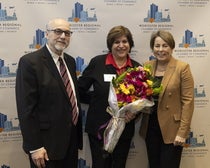Central Mass. Firms Feel Sting Of Federal Budget Cuts
Bob Fichtel, who runs a one-person marketing and design studio out of Ashburnham, wasn’t shocked when business dipped 10 percent this year. After all, times continue to be tough.
But he wasn’t expecting that drop-off to come out of a phone call he received in April from a national microscope manufacturer, who notified him that sales were down 29 percent due to sequestration, some $85.4 billion in federal defense and discretionary spending cuts that went into effect March 1.
The manufacturer, which comprises 20 percent of Fichtel’s business, decided in turn to slash its marketing budget — aka Fichtel — in half.
“I never once thought the sequester would come down to my level,” Fichtel said. “You think of it as big government and large corporations ... getting cut.”
Nearly eight months after the cuts took effect, sequestration hasn’t brought deep pain to most Massachusetts companies, but the breadth of its impact can’t be understated.
“I think lately we forgot the importance of the federal government in our day-to-day lives,” said Maureen Dunne, an economist with the MetroWest Economic Research Center at Framingham State University.
That’s especially true in Massachusetts, which receives the second-highest amount of Small Business Innovation Research (SBIR) grant money of any state in America, according to Joseph Donovan, a lobbyist with the Boston law firm Nelson Mullins Riley & Scarborough.
Prior to the sequester, the Bay State took in $7.7 billion of federal money for research and development, and $14.5 billion in Department of Defense expenditures, the fifth highest among the states, according to Robert Nakosteen, a professor of economics and statistics at the Isenberg School of Management at the University of Massachusetts Amherst.
“Planned federal budget cuts loom as a Damoclean sword over the state’s economy,” Nakosteen wrote in a 2012 report.
The sword cut swiftly at University of Massachusetts Medical School, where $10.7 million in funding was lost out of a total budget of $242 million, said Dean and Provost Terry Flotte. Agencies like the National Institute of Health and National Sciences Foundation are now accepting just 6 percent of grant applications, Flotte said, as opposed to more than 20 percent prior to the sequester.
“It’s beginning to cause people to rethink their career choices,” Flotte said. “What I’m worried about is that we’re going to have lost a generation of scientists.”
At the Natick Solider Systems Center, part of the U.S. Army, all 1,500 civilian employees were required to take six furlough days between early July and mid-August, spokesman John Harlow said. That cost the workers — and the MetroWest economy — some $2.67 million in wages.
“Something that would normally take 10 days to do now took 12 days to do,” Harlow said. Employees at the center – also known as Natick Labs - spend much of their time researching military equipment as well as biomechanics to increase soldier performance.
The Effect On Nonprofits
Sequestration slashed the administrative budget at RCAP Solutions from $6.5 million to $5.8 million, forcing the Worcester-based housing nonprofit to lay off seven of its 88 workers over the past three months as contracts expired, according to its president, Karen Koller. RCAP helps people in the Worcester area with issues ranging from homelessness to domestic abuse to rental vouchers.
The cuts could result in service delays, Koller said, such as processing applications or answering and returning phone calls.
RCAP’s funding will likely be reduced by at least another $300,000 if the sequester continues into a second year, Koller said. RCAP receives funding from four sources, the largest of which is the U.S. Department of Housing and Urban Development.
“We can’t see everyone at the same level each day,” she said. “You can’t cut out the people who are the service providers to the people in need.”
But outside of certain sectors that depend heavily on federal contracts and grants — such as defense, pharmaceuticals and medical devices — the sequester hasn’t yet left too much of a mark.
“We know it’s an issue, but it’s not something we’re hearing about from our firms everyday,” said Christopher Geehern, executive vice president at Associated Industries of Massachusetts.
That’s because most companies were able to stave off the initial effects of sequestration by shifting their workload or using reserve funds, Donovan said. Biotech giant Genzyme said the sequester hasn’t affected it too much thus far, according to spokeswoman Lori Gorski, though the Cambridge-based company is monitoring National Institutes of Health funding going forward.
Geehern said defense and research contracts are typically granted over several years, meaning problems won’t typically arise until those deals are up for renewal. Sensing trouble on the horizon, most companies pushed to get federal contracts lined up and signed prior to the start of the sequester, Dunne said.
Companies typically refrained from laying off highly skilled employees, Nakosteen said, presuming the spending cuts wouldn’t last. They figured they had enough money in the short run to support the same number of workers even with fewer direct contracts.
But that becomes much harder if the sequester isn’t modified or eliminated and an additional $85.4 billion is slashed from the federal budget each year between 2014 and 2022.
“Sequestration is like a melting iceberg,” Donovan said. “You don’t see the impact after a day or even a week, but come back in six months or a year and you’ll definitely see the impact.”
That impact is nearly here, Nakosteen said. He thinks the Bay State is on the verge of having major technology companies make sequestration-related layoffs, and he expects the sector — despite being one of the commonwealth’s most dynamic — to have virtually zero growth between now and the end of the year.
“Sequestration was the worst thing to do at the worst time,” Nakosteen said.
But others are more skeptical that the spending cuts will send the economy in a tailspin.
Bryan Engelhardt, an assistant professor of economics at the College of the Holy Cross in Worcester, pointed out that the recession ended in 2009 and that the country is already in the middle of a new business cycle. He acknowledged that sequestration might have begun a little earlier than what would have been ideal, but he isn’t too concerned since the cuts are being implemented gradually over a decade.
“If you’re going to be stimulating the economy when things are bad, you need to spend less when things are good,” Engelhardt said.
Still, Engelhardt expects sequestration to cost the U.S. more than 550,000 jobs over the next decade while slowing annual gross domestic product growth from 2.5 percent to 1.5 percent.
The cuts stemmed from a compromise to raise the debt ceiling in August 2011. A bipartisan “super committee” in late 2011 failed to reach an agreement on how to cut $1.2 trillion to offset some of the federal debt. That triggered the automatic sequester cuts in early 2013.
“It’s hard to be optimistic due to the intransigence of some people,” said Tim Murray, president of the Worcester Regional Chamber of Commerce. “That requires give and take, and compromise.”















0 Comments